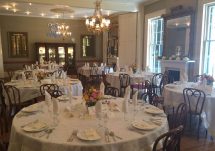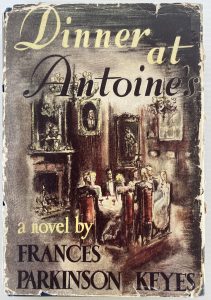Dinner at Antoine’s (Frances Parkinson Keyes)

(1949).
“Keyes” rhymes with “skies” not “keys”. Being privy to arcane pronunciations is the sort of marker which separates those who are in New Orleans Society from those who are not. Only the former know that the sidewalk in 1940’s-50’s New Orleans is called the “banquette”. Only the former are admitted to Antoine’s Restaurant on St Louis Street without a long wait on the banquette, if at all. Orson Foxworth is certainly one of the former and, on a warm afternoon, is immediately lead into the special lunch room when he entertains his niece and several intimate friends.
The layout and history of the restaurant are expanded upon in great detail, as are Foxworth’s equally ridiculously named guests – Leonce St Amant, Caresse LaLande, Sabin Duplessis. Foxworth’s guests are beautiful and fabulously dressed. Meet Amelie – a youthful and soigne widow. “Her corn-coloured hair lay in great coils above the soft ringlets which framed her radiant face. Her big blue eyes snapped and sparkled. Her delicately rouged lips parted over tiny white teeth. Her svelte figure triumphed over the exacting cut of her dress“. Keyes never met an adjective or adverb she didn’t want to work to death, sometimes to unintended effect. “Snapping eyes” and “tiny teeth”? Don’t feed Amelie after midnight. Foxworth’s Washington niece, Ruth Avery, “attractive and intelligent and well poised and pleasant and dependable and sincere” is the only one with the name and hair (natural chestnut curls) of a real human. Ruth is visiting her suave Louisianan uncle in louche New Orleans and looking to get hitched.
Nor are we spared descriptions of the the food at Antoine’s – presumably on the real menu of the real restaurant in the immediate post-war period. It sounds revolting. Take huitres Foch, “So he spread toast with pate de fois gras, and heaped fried Louisiana oysters on top of that, and poured Madeira sauce over the whole thing“. If you don’t like the sound of that, you can have “glistening, ruby-coloured” globules of shrimp in aspic.*
The clothes of past beauties are given a similar close study, including annual pageant winners from 1900. The present belles are described too. We already know that Clarinda has dreamy eyes, a slow, charming smile, slow grace, tapering white fingers and exquisite oval nails. Now we see her…. “evidently on the point of starting to a large afternoon party, for she was dressed as if for some festive occasion. Emerald green plumes swept gracefully across her glossy hair from the crown of her small sable hat; her close-fitting jacket and full, ankle-length skirt were make of emerald green velvet, sable trimmed, and she was carrying a large sable muff. Framed as she was by the white columns, she might have stepped straight from a canvas by Goya; yet this exquisite picture seemed to have been mysteriously modernised by the hand of some still greater master.” The sort of great master who imagines Sherwood Forest/Gone with the Wind themed afternoon parties.
The mansions are equally lovely and outdated. “The regalia which Odile had worn as Queen of the Pacifi completely filled a glass-walled cabinet and several similar cabinets were crowded with Dresden china, Dutch silver, snuff boxes, and other miscellaneous bric-a-brac. A series of antique fans, encased in frames which followed their shape, and a set of bisque figurines, representing amorous shepherds and coy shepherdesses, added to the general effect of artificiality and uselessness.”
The staff and servants do not have beautiful visages, figures or minds. They are not quite human. “The maid’s prompt appearance suggested that she might have been lurking nearby hoping for just such a summons. At all events, when she entered her expression was one of eager anticipation. And this became even more marked as she rolled her large velvety eyes from one pile of clothing to another. ‘You may have all the things on the bed, Lop,’ Caresse told her. ‘That is, you may take them away and divide them with Ona. Mind you don’t try to play any tricks though. I’ll check with Ona later and find out whether you’ve been fair.’ ‘Ain’t gwine play no tricks, Miss Caresse. Ah don tol’ Ona already you was a-fixin’ to give us some of yo’ pretty clo’es. Us’n mightly proud to git ’em, Ah kin tell you.’ Lop reached over the bed and swept the clothing that lay there into her covetous arms….She laid down the others and bent to pick up the straying garments, gasping with incredulous delight.”
An international merger and a murder mystery scaffold all of this. A pistol appears in the first act. There’s a faithless husband, a saintly doctor, a missing note, a purloined key, a fake alibi, a roving reporter, shadows on a blind, inscrutable foreigners and long discussions about opportunity and motive. These shenanigans do not convince. Nor does the rather odd incident in which a lifelong playboy bachelor suddenly ditches the chaste object of his many years of adoration when she says the wrong thing; spurns her utterly, and almost immediately thereafter, falls instantly in love with the perfect (much younger) woman who has admired him from afar and is only in the book for that plot point.
So, this book and its characters are vapid, generally pretty, overrated and rather amusing. We feel that at times Keyes is as contemptuous of her characters as she is adoring. She knows that they are all rather silly and tasteless. If you like that kind of society, now and then, then this will amuse you.
[* Sounds like the kind of Louisianan fare described by A.J. Liebling – ed.]Leave a comment...
While your email address is required to post a comment, it will NOT be published.




1 Comment